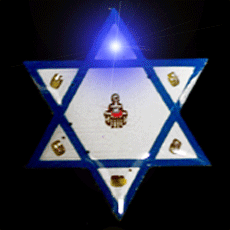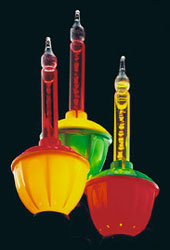Sunday, December 23: The A.D.D. Detective
The CHRISTMAS BOX
by Leigh Lundin
 Every Christmas, my father gave my mother a box, the same box, a 10 inch (25 cm) cube with printed poinsettias. From their first Christmas together, my sentimental father saved the carton and each year he gave her a gift in that same box. That was one of several family traditions.
Every Christmas, my father gave my mother a box, the same box, a 10 inch (25 cm) cube with printed poinsettias. From their first Christmas together, my sentimental father saved the carton and each year he gave her a gift in that same box. That was one of several family traditions.
Christmas was ecumenical for us. My family surrounding consisted of Protestants, Catholics, Jews, a closet Buddhist, and of course the batty spinster aunt who went on about "astral planes". Unlike nations, our various religions didn’t divide us; they brought us together. As in the spring, when we celebrated Passover, Easter, and Purim together, in the winter, we embraced Chanukah and Christmas.
Alongside holly and juniper boughs, my mother set out a menorah. My Aunt Esther’s star atop the tree looked suspiciously like a Star of David (much more tasteful than the example at right). We were delighted when we discovered the 25th is the FIRST day of Christmas, so by tradition we could leave the tree up through the 6th of January, the Feast of the Epiphany.
| 1st day | 25 Dec | 5th day | 29 Dec | 9th day | 02 Jan | ||
| 2nd day | 26 Dec | 6th day | 30 Dec | 10th day | 03 Jan | ||
| 3rd day | 27 Dec | 7th day | 31 Dec | 11th day | 04 Jan | ||
| 4th day | 28 Dec | 8th day | 01 Jan | 12th day | 05 Jan | ||
| 6 January : Feast of the Epiphany or ‘Little Christmas’ | |||||||
We experienced Christmas as inclusive, not exclusive. We had no Muslims or Shintoists in the family, but they’d have been told, "Pull up a chair, don’t sit on the cat, and help yourself to date pudding."
We attended the usual rounds of Christmas pageants, religious services, candle lighting, and chorales. We endured pleasant bickering, my mother’s seasonal hyper-sensitivity, and a droning background lecture about the feminist meaning of an astral Christmas or the astral meaning of a feminist Christmas.
My aunt Charlotte hand-made Christmas stockings, decorated with miniature wreaths, holly, and candy canes. Christmas Day was reserved for stockings, so Christmas Eve we sat around the tree and opened our ‘major’ presents. Before bedtime, when the air was pungent with the latest cologne and airplane glue, we hung stockings on the mantle. Next morning, we emptied our stockings to find tangerines, English walnuts, Matchbox cars, toys and tchotchkes (Yiddish for ‘trinkets’), whereupon my youngest brother stuck small parts up his nose.
(In fact, he was a strange little brother. In church, my mother noticed he’d begin chewing. She’d open his mouth and find peas from the previous night’s dinner. This was after he’d (a) brushed his teeth, (b) slept through the night, (c) eaten breakfast, and (d) brushed his teeth again. Somewhere, he had a squirrel-like pouch in his cheek where he stored food.)
 I loved NOMA bubble lights from my first Christmas, the year after they were introduced. I believed bubble lights had disappeared from the scene, but several years ago I discovered bubble lights are still manufactured. In fact, Florida has Bubble Room Restaurants which feature more than a few bubble lights as well as loads of nostalgic kitsch.
I loved NOMA bubble lights from my first Christmas, the year after they were introduced. I believed bubble lights had disappeared from the scene, but several years ago I discovered bubble lights are still manufactured. In fact, Florida has Bubble Room Restaurants which feature more than a few bubble lights as well as loads of nostalgic kitsch.
The lighting of our tree was as big an event as Rockefeller Center or the White House. One uncle grumbled that he wanted to get lit as my aunt prattled on about pagan lesbian symbolism on the astral plane. I think my uncle muttered something about ‘astrals’, although his spelling had a double ss.
(Disney’s tree in the Magic Kingdom is our major local event. The ‘magic’ is that Disney buys two trees to make one Christmas tree. On a back lot, they dismember one and wire its branches into the other tree making the result appear denser and fuller. Once satisfied, they spray it with a transparent green lacquer and fire retardant. From a warehouse, they pull lights, ‘popcorn’ strands, and oversized decorations that utilize forced perspective. On the last night of November, a crane sets the tree into place in the Magic Kingdom.)
A couple of years ago, a teacher was threatened with dismissal after she told her students Santa wasn’t real. Parents wailed and wrung their hands that little Dick and Jane would be traumatized to learn that Santa and his 8 (or 9) reindeer were made up.
My batty aunt used to say, "Santa doesn’t exist, you know."
"Well, duh! You believe in astral projections, but not Santa?"
We always knew Santa didn’t exist. That didn’t stop us from enjoying the fantasy. We loved the wonderful events comprising Christmas and we appreciated some adults wouldn’t condescend or lie to their kids.
My father died before my parents achieved their 50th anniversary. Never again would my mother open their sentimental Christmas box my father saved nearly a half century earlier and annually re-given her. Although it was in remarkable shape, it had yellowed with age. Its use was past, yet a memory like that doesn’t belong in the trash.
That winter without him, my mother closed the lid on the box and built a ‘yule log’ bonfire. In the flames, she placed the Christmas box, the one she’d received each holiday for all those many years.
Here’s a little Christmas gift passed along by writer/editor/friend, Sharon:




















tsochkes (Yiddish for “trinkets”)
M. Leo Rosten, in his epochal work The Joys of Yiddish, notes the following:
tsatske
tsatskeleh
tchotchke
tchotchkeleh
Pronounced TSAHTS-keh-leh to rhyme with “Oscela”; TCHOCH-keh, to rhyme with “botch a”; TCHOCH-keh-leh, to rhyme with “notch a la.” From Slavic: shalet: “to play pranks.”
Tsatske and tchotchke are used interchangeably. Tsatskeleh and tchotchkeleh are affectionate diminutives of tstatske and tchotchke.
A tsatske is:
1. A toy, a little plaything. “I brought the child a tsatske.”
2. An inexpensive, unimportant thing: a gewgaw; a trinket. “He gave her some tsatske or other for her trouble.”
3. A bruise, a contusion, wound. “He had a tsatske under each eye.”
4. A nobody; no bargain. “Don’t listen to that one; he’s a tsatske.”
5. A misfit, an unadjusted child, a problem and a burden to one and all. “What can we do about him? Since he joined the club he’s been a tsatske.”
6. A loose or kept woman.
7. An ineffectual person, a fifth wheel, a disappointment.
But the usages I most relish are:
8. A cute female; a pretty little number; a chick; a babe; a playgirl.
9. A sexy but brainless broad.
At one time, so I am told, West End Avenue in New York had an inordinately high proportion of tchotchkies (plural).
___
Old Mr. Gluck had finally moved to the suburbs. On a trip into New York, he met a friend who bombarded him with questions. “How do you like it? Living in the country, so far from everyone!”
“At first I had problems,” said Gluck. “I thought I’d never be able to stand it! Then I listened to my neighbors, and got me a paramour. From then on, everything has been fine!”
“A paramour? You? Gluck, how can you do such a terrible thing? What does your wife think?”
“My wife?” frowned Gluck. “Why should she care how I cut the grass?”
___
JLW resumes: I only point this out because those of us who prefer the more pure Slavic-oriented Yiddish think that tsatske is superior to the now ubiquitous tchochtkie. Anyhow, I think that “bauble” is a closer translation than “trinket”.
But what the hell do I know? I’m a gentile.
My mother had those bubble lights on our tree and I can remember her telling us not to touch them because they were hot. I stood in front of the tree until they started bubbling. I think now they are different and have instant gratuitous bubbles.
Very lovely article. I cried. But a nice cry. What a sweet marriage your parents must have had.
Thank you. My parents set a good example.
Naturally, I touched the bubble lights and they were very warm without being searing. In researching a bubble light source, I came across a type of ‘instant’ bubble light that has plastic ‘bubbles’ embedded in acrylic. Bah, humbug!
James, I’ve been on West End Av, but I think the word is ‘trollop’. Or tranny. Not many of the girls there are cute. Or necessarily girls.
Great column, Leigh. And like the best of short stories, it has multiple twist endings, from your Auntie Astral (which made me chuckle) to Dad’s touching yuletide farewell (which brought a tear to my eye).
As to tsochke, tchochtkie, or whatever-the-hell, there’s only one correct way to spell it, and you have to use Hebrew letters: ???????? (not everyone’s browser will display it correctly, but you get the idea).
I’ve always pronounced it “choch-kuh” (with a “ch” consonant in the first syllable, and a schewa vowel in the unaccented second syllable). But what do I know?
As my comment went up, I found that ?????? didn’t even come up correctly on my browser. I’ll try giving you all a hyperlink to a Yiddish dictionary.
Spelling in Yiddish is an art, and not a science, even in the Hebrew alphabet, especially since so many Yiddish words are not Hebrew in origin. I don’t think there’s anything wrong with using the Latin or Cyrillic alphabets to spell particular Yiddish words.
Rosten, for example, spells shmuck without a “c” between the “s” and the “h”–but the word, Yiddish for the membrum virile, is derived from the German schmuck, meaning “jewel”, and that is how you will usually see it spelled.
Jewel, huh? I now feel so precious.
NOMA Bubble Lights! In the early sixties my ex-husband worked in the Noma Lights New York office mail room as his summer job during high school.
Although the company had closed by the time we married, we did have a great set of bubble lights! I wonder if he still has any? I’ll have to ask him.
Great Christmas post! Terrie
Leigh, I hate to break it to you, but any “jewels” the word “shmuck” refers to are of the family variety.
And see, growing up Jewish I never had the joy of NOMA Bubble Lights!
Quite the potpourri of responses to Leigh’s article, of which includes NOMA lights, Yiddish lessons and family jewels.
I am now convinced it takes a very ‘different’ sort of person to be an author. You have garnered my admiration.